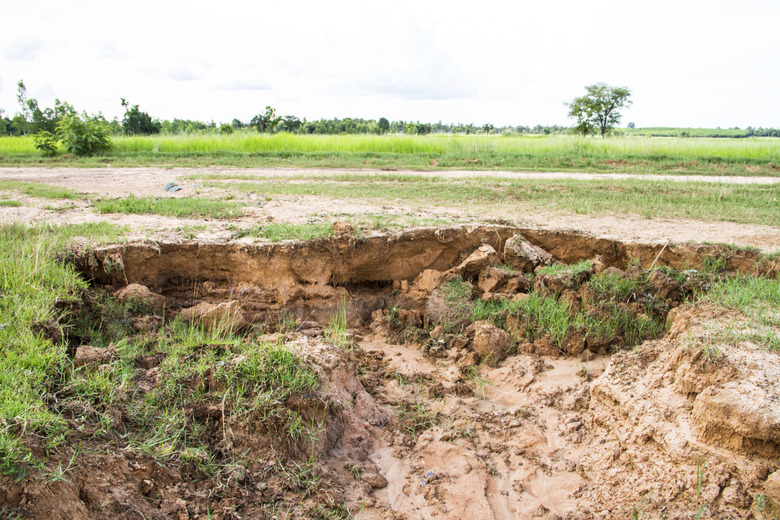How To Calculate Erosion Rate
The soil erosion rate is the loss of soil mass over time for a specific land area. Erosion is a natural process caused by wind, rain and moving water. Soil erosion affects farming, construction projects and homeowners living near rivers, oceans and on terrestrial slopes. Excessive erosion is often caused by human activities, such as deforestation, road construction and intensive farming. You can calculate the soil erosion rate by measuring the loss of soil mass over a specific time period. To predict future soil erosion due to water, scientists developed the Universal Soil Loss Equation, or USLE.
Calculating Eroded Soil Mass
Calculating Eroded Soil Mass
Soil mass is the volume of soil multiplied by its density. The density of soil is affected by its compactness and by how much organic material it contains. To calculate the volume of soil eroded by water runoff in a specific area, measure the square area multiplied by the change in depth. For example, if the area in square meters is 20,000 and the lost soil height is 0.01 meters, then: Volume = 20,000 x 0.01 = 200 cubic meters. Assuming the soil density is 150 kilograms per cubic meter, multiplying the volume by the density gives you the eroded soil mass: Mass = 200 x 150 = 30,000 kilograms.
Calculating the Erosion Rate
Calculating the Erosion Rate
The erosion rate measures the amount of soil mass lost over a specified time period. If 30,000 kilograms of soil was lost over four years, then: Erosion rate equals 30,000 divided by 4, or 7,500 kilograms per year. To compare erosion rates in different land areas, you need to calculate the rates for a unit area, such as one square meter or one acre. Simply divide the erosion rate by the number of square meters or other square units. Make sure that you use the same type of units in all your calculations, whether it is meters, kilometers, feet, yards or miles.
Predicting the Annual Erosion Rate
Predicting the Annual Erosion Rate
Farming, building, landscaping and conservation projects often need to know the predicted annual erosion rate. Climate, soil type, vegetation and the slope of the land all affect the erosion rate. Increased rainfall and water runoff break down soil aggregates and impact erosion. Vegetation and the roots of vegetation impede erosion. Steeper slopes have greater soil loss from water erosion. To consider these factors in predicting the annual erosion rate, the Universal Soil Loss Equation, USLE, was created.
Universal Soil Loss Equation
Universal Soil Loss Equation
The Universal Soil Loss Equation, or USLE, predicts the average annual soil loss "A" per unit area. The equation is A = R x K x L x S x C x P and multiplies various factors to arrive at the annual erosion rate. The R factor is based on rainfall and runoff, while K is the soil erodibility factor and depends on the type of soil. The L and S factors are usually considered together and are measures of the length and steepness of a slope. The C factor, or crop management factor, and P factor, or support practice factor, usually only apply to cropland or land that is managed to conserve soil. In the United States, values for the USLE are available from various U.S. Department of Agriculture and Natural Resources Conservation Service soil surveys. Although the USLE was derived to measure cropland erosion, it is globally applicable, in modified form, to many types of water erosion problems.
Using the USLE
Using the USLE
To use the USLE, obtain the value for the R factor from your local weatherstation or another agency. Determine what type of soil you have to assign a value for the K factor; clay with average amounts of organic matter has a K factor of 0.49, while very fine sand has a value of 0.96. Measure the length of the slope of the land and determine the percentage of slope to derive the LS factor. An eight percent slope that is 30.5 meters long has an LS factor of one. If you don't use the land for crops, the C and P factors are generally equal to one. These factors vary between zero and one if land is actively farmed and tilled. Assuming that the R factor is 100, the K factor is 0.40 and your 30.5-meter-long land area has a two percent slope, giving you an LS factor of 0.2, then soil erosion = 100 x 0.40 x 0.2 x 1 x1 = 8 tons per acre per year for non-farmed land.
Cite This Article
MLA
Blue, Marie-Luise. "How To Calculate Erosion Rate" sciencing.com, https://www.sciencing.com/calculate-erosion-rate-6118473/. 24 April 2017.
APA
Blue, Marie-Luise. (2017, April 24). How To Calculate Erosion Rate. sciencing.com. Retrieved from https://www.sciencing.com/calculate-erosion-rate-6118473/
Chicago
Blue, Marie-Luise. How To Calculate Erosion Rate last modified March 24, 2022. https://www.sciencing.com/calculate-erosion-rate-6118473/
